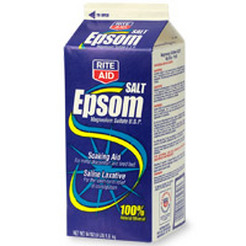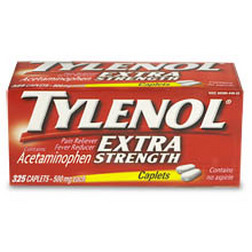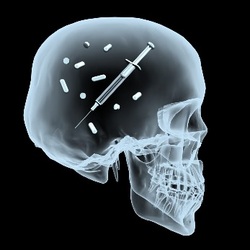RECOVERY
Medicine
Epsom Salt (Magnesium Sulfate)

Epsom salt is an old but effective product that has many uses:
For more information about epsom salt, click here.
- Dissolving epsom salt into a bath filled with warm water is a great way to relieve pain from bruises, sprains, and muscle soreness. Submerge the targeted area in the water for at least twenty minutes.
- Epsom salt is great for your hair and scalp. Add eight tablespoons of epsom salt per half a cup of shampoo. You can also mix epsom salt into conditioner, leaving it in your hair for twenty minutes before rinsing it out.
- Epsom salt can be used to treat dry skin. You can apply epsom salt directly to the skin, leaving it smooth and silky.
- If you are constipated, mix two to four teaspoons of epsom salt into a glass of water and drink it. Although it might taste bitter, drinking epsom salt dissolved in water twice a day should eliminate constipation.
For more information about epsom salt, click here.
Tylenol (Acetaminophen)

Tylenol, also known as Acetaminophen, is an over the counter drug that is used to relieve mild to moderate pain. This medication is frequently used to relieve headaches, sore muscles, sore throats, menstrual periods, colds and coughs, reactions, and fevers. Acetaminophen is an analgesic (a pain reliever) and an anitpyretic (fever reducer); thus it alters a person's level of pain tolerance and cools the body. Acetaminophen can be taken as swallowable tablets, chewable tables, liquid, or powder.
Acetaminophen may be used in combination with aspirin and caffeine to relieve the pain associated with migraine headaches. Like any other medication, it is best to consult a doctor prior to taking Tylenol. In addition, avoid consuming alcohol while taking Tylenol. The side effects of this medication include rashes, hives, itching, swelling, and difficulty breathing or swallowing. For more information about Tylenol, click here.
Acetaminophen may be used in combination with aspirin and caffeine to relieve the pain associated with migraine headaches. Like any other medication, it is best to consult a doctor prior to taking Tylenol. In addition, avoid consuming alcohol while taking Tylenol. The side effects of this medication include rashes, hives, itching, swelling, and difficulty breathing or swallowing. For more information about Tylenol, click here.
Drug Recovery
We all know that taking drugs and drinking excess alcohol is unhealthy, but why is this the case? Through electrical impulses in networks of nerve cells called neurons, messages from the brain are sent to the rest of the body. Messages are transmitted between neurons by chemicals called neurotransmitters. Drugs and alcohol are substances that can interfere with that chemical communication by mimicking the natural chemicals that occur in the brain. For example, heroin and marijuana causes the brain to send abnormal messages, and stimulants such as cocaine causes the brain to unnaturally release very large quantities of chemicals. Thus, by consuming these substances, the brain and the nervous system becomes flooded with false signals, leading to weakened judgment, balance, and overall brain function.
People have historically believed that drug and alcohol addiction is a result of moral weakness, and that people could stop taking drugs whenever they wished. However, modern researchers have found that drugs and alcohol stimulate chemical changes that produce feelings of pleasure in the limbic system, the brain's pleasure pathways or reward centers. The brain learns to repeat activities that produce pleasurable feelings, such as taking drugs or alcohol. This is how addiction typically begins.
The brain learns to repeat actions that produce feelings of pleasure, such as taking drugs.
Therefore, the recovery process from drug addiction is not that easy. One method of recovering is to completely refrain from using the drug, called abstinence. However, some people’s bodies are incapable of such quick withdrawal of drug use, and begin to feel uncomfortable physical or mental changes when their bodies are deprived of the alcohol or drugs they are accustomed to getting. Withdrawal symptoms include nausea, vomiting, sweating, shakiness, and anxiety. Items such as nicotine patches are used to alleviate the withdrawal process gradually reduce the amount of drugs that are taken. These patches release small doses of nicotine so the addicts' bodies can still function properly. Another method to overcome addiction is to seek help from professionals at a counseling center that can also help ease the patient out of drug use.
After recovering from drug addictions, patients are still prone to relapse and falling back to the use of drugs. By being introduced to drugs, they are physically and mentally not the same people they used to be. Even after recovery, they may never revert to the original lives that they had once lived.
People have historically believed that drug and alcohol addiction is a result of moral weakness, and that people could stop taking drugs whenever they wished. However, modern researchers have found that drugs and alcohol stimulate chemical changes that produce feelings of pleasure in the limbic system, the brain's pleasure pathways or reward centers. The brain learns to repeat activities that produce pleasurable feelings, such as taking drugs or alcohol. This is how addiction typically begins.
The brain learns to repeat actions that produce feelings of pleasure, such as taking drugs.
Therefore, the recovery process from drug addiction is not that easy. One method of recovering is to completely refrain from using the drug, called abstinence. However, some people’s bodies are incapable of such quick withdrawal of drug use, and begin to feel uncomfortable physical or mental changes when their bodies are deprived of the alcohol or drugs they are accustomed to getting. Withdrawal symptoms include nausea, vomiting, sweating, shakiness, and anxiety. Items such as nicotine patches are used to alleviate the withdrawal process gradually reduce the amount of drugs that are taken. These patches release small doses of nicotine so the addicts' bodies can still function properly. Another method to overcome addiction is to seek help from professionals at a counseling center that can also help ease the patient out of drug use.
After recovering from drug addictions, patients are still prone to relapse and falling back to the use of drugs. By being introduced to drugs, they are physically and mentally not the same people they used to be. Even after recovery, they may never revert to the original lives that they had once lived.
Sources:
The 800-Cocaine Book of Alcohol and Drug Recovery
http://addictionrecoverybasics.com/what-is-addiction-part-3-of-3-addiction-as-a-brain-disease/
http://www.drug-rehabs.org/withdrawal-symptoms.htm
http://www.mediorta.com/wp-content/uploads/2009/09/drug-rehab.bmp
http://www.torquerelease.com.au/Drug%20Head.jpg
http://youngadultdrugrehab.org/wp-content/uploads/2010/09/drug-rehab-counseling.gif
http://addictionrecoverybasics.com/what-is-addiction-part-3-of-3-addiction-as-a-brain-disease/
http://www.drug-rehabs.org/withdrawal-symptoms.htm
http://www.mediorta.com/wp-content/uploads/2009/09/drug-rehab.bmp
http://www.torquerelease.com.au/Drug%20Head.jpg
http://youngadultdrugrehab.org/wp-content/uploads/2010/09/drug-rehab-counseling.gif


